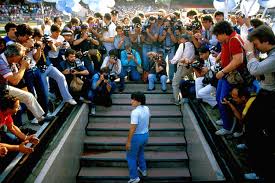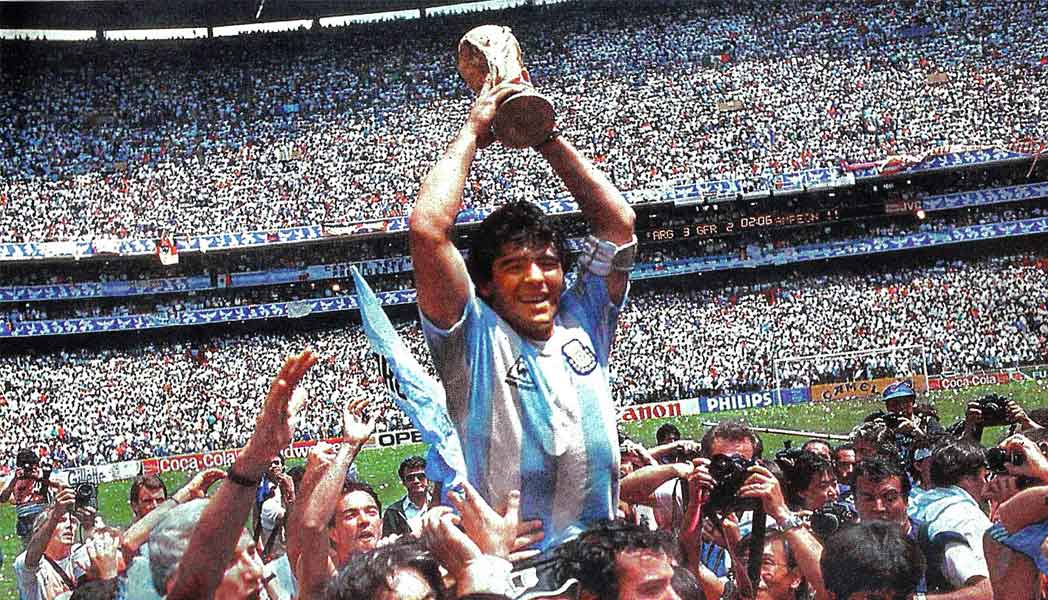Directed by the Academy award-winning documentary filmmaker, Asif Kapadia (Amy, Senna), this documentary explores the life of the legendary Argentine, "El Pibe de Oro" ("The Golden Boy"), whom many regard as the greatest football player of all time.
Most of us know the unfortunate fate of this football genius come nutter. Through dissecting over 500 hours of footage, Kapadia attempts to deconstruct Diego Maradona’s rise and fall. The story is largely told in the words of Maradona himself and those closest to him, including his wife Claudia and his trainer Fernando Signorini at Napoli football club, where Maradona spent the 7 years that Kapadia clearly sees were key to the footballer's destiny.
Unusually for an English journalist treating this particular subject, Kapadia starts from a place of neutrality in his attempt to reach the nugget of truth, rather than a place of preconceptions. When it comes to Maradona, the English are rarely able to shed their puritanical position, whether about the player’s lifestyle or the fact that he cheated in the World Cup of Mexico’ 86 against England.
We start in 1984 and, despite some foreboding words from Pele (the world's greatest ever footballer before Diego came along) that hang ominously throughout the film, Diego arrives in Naples as a fresh-faced exciting talent, still eager to prove himself on the pitch after two frustrating seasons in Barcelona, where he was injured then involved in a brawl and nobody wanted to buy him.
Kapadia takes us on the 24-year-old’s exhilarating ride (literally - the movie starts with what looks like a car race to the stadium to introduce Maradons to the fans) as the new player single-handedly transforms Napoli, a failing club that has never won anything and on the verge of relegation, to Italy’s top team. We are captivated by Diego’s love of football and the social significance of proving the worthiness of a city and people scorned and racially abused by the rest of Italy. This achievement, and the love that Napoli the club and Naples the city reward him with, fills the boy from the Buenos Aires’ slums with joy.

Some of film's most insightful comments come from Diego’s trainer, Fernando Signorini who is the first to separate ‘Diego’ the affectionate, genuine, hardworking, ambitious, clever and likeable boy with insecurities, from ‘Maradona’ the persona that Diego is forced to create in order to cope with the relentless idolatry placed upon him by the Neapolitans. The scenes of adoring crowds maulling the poor boy impress on you the suffocation and ultimate imprisonment that the city’s expectations imposed on its saviour.
Like a Shakesperean tragedy, Kapadia provides a key moment that decides the footballer’s fate. After Maradona has delivered the Cup and the league to Napoli, raising the club’s value and the esteem of a city to a level it had never dreamed of, Maradona asks the Napoli owner to release him. He himself knows the danger of what lies ahead and seeks to develop a healthier relationship with a new club, but Napoli refuses to grant his wish and from this moment things go downhill.
While previously Diego’s escape had been on the pitch, his diminishing enthusiasm for the club and inability to lead a normal social life, drive him to other escapes; the drugs and sex of the Neapolitan underworld. The cocaine addiction he develops binds him further to those who seek to manipulate him.
The likeable, fun-loving Diego becomes more and more remote and the sour, aggressive, Maradona takes over. The gold Rolexes, red Ferraris and white limosines that are showered upon him, become the only compensation for living in this trap. Yet, football remains always the only incentive for Maradona to clean up his act, as he does for both the 1986 and the 1990 World Cups.
In the end, however, football itself becomes Maradona’s enemy, after Argentina beats Italy in World Cup 1990 in italy, and in the very Napoli stadium, on penalties, with Maradona in the impossible position of scoring the winning penalty. From then on, argues the film, Italy despises him and the very city that had protected Maradona, even covering up his urine tests, orchestrates his demise. With a year long ban for cocaine trafficking, Maradona leaves Naples for Argentina, a hated man and with football taken away from him, leaving him only with a cocaine addiction and the lavish lifestyle.
Ultimately of course, Diego makes very bad decisions when he doesn’t have to. As Signorini says, Maradona continually drags Diego down. Diego himself confesses later; he didn’t listen to the people who most cared for him, his trainer, his wife and he must take responsibility for his bad decisions. But, one is left wondering what may have happened if Napoli had allowed Diego to leave when he wanted to.
In this film Maradona is treated as classic tragic hero, with all the fatal flaws. One is left with the enduring image of the boy from the slums who only wanted to play football and buy an apartment for his parents. It is satisfying that someone has attempted to understand and empathise with a character that has been either idolised or vilified, but rarely treated as a human being. Most of all, let's hope that if Diego Maradona watches the movie (which as yet he apparently hasn't) he sees in it the chance for redemption.
Diego Maradona the movie is in cinemas from today
We are giving away a signed movie poster (signed by Asif Kapadia). To enter the draw send the words Maradona via our contact page
















